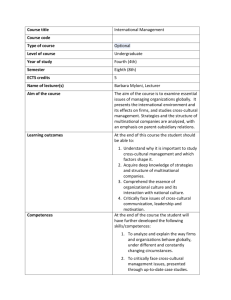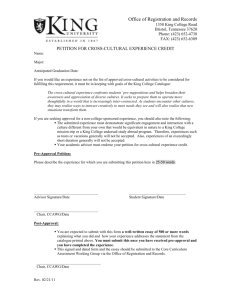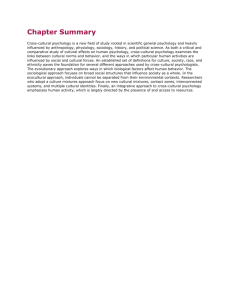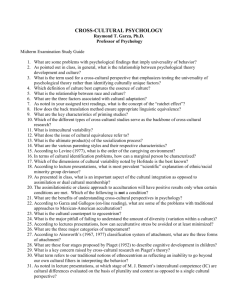What is Culture?
advertisement
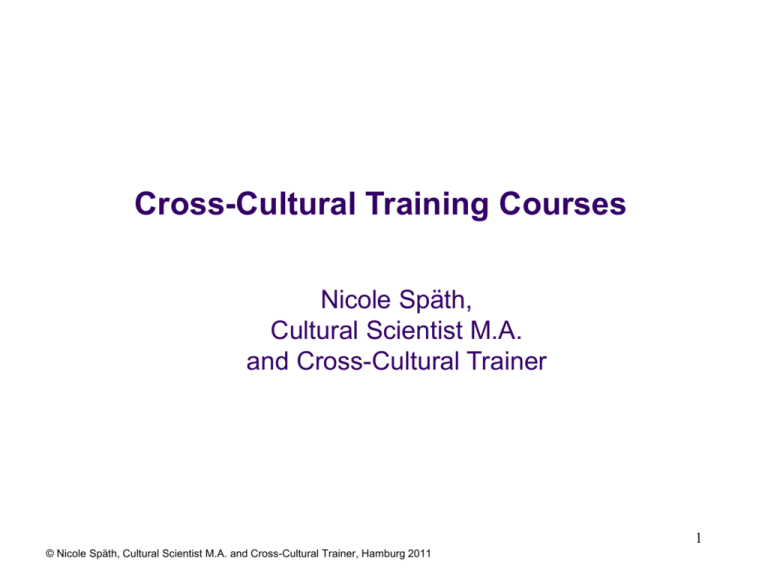
Cross-Cultural Training Courses Nicole Späth, Cultural Scientist M.A. and Cross-Cultural Trainer 1 © Nicole Späth, Cultural Scientist M.A. and Cross-Cultural Trainer, Hamburg 2011 Introduction into Culture, Cross-Cultural Communication and Cultural Standards 2 © Nicole Späth, Cultural Scientist M.A. and Cross-Cultural Trainer, Hamburg 2011 “We ... say of some people that they are transparent to us. It is, however, important as regards this observation that one human being can be complete enigma to another. We learn this when we come into a strange country with entirely strange traditions; and, what is more, even given a mastery of the country‘s language. We do not understand the people.“ (Wittgenstein, in: Geertz, 1973) 3 © Nicole Späth, Cultural Scientist M.A. and Cross-Cultural Trainer, Hamburg 2011 What is Culture? 4 © Nicole Späth, Cultural Scientist M.A. and Cross-Cultural Trainer, Hamburg 2011 There are many different definitions of Culture. In the Cross-Cultural Communication anthropological definitions are often used: Cultures are webs of significance, spun by human beings, with a lot of signs (=acts) – thick description is anthropological practice of explaining with as much detail as possible the reason behind human actions. (cp. Geertz 1973) Culture is a common (invisible) system of values and meanings, that becomes visible by people‘s behaviours and actions as well as by specific artefacts. (cp. Maletzke, 1999) Culture is a universal, typical system of orientitation of a society, organisation or a group. (cp.Thomas, 1996) Culture is the entirety of human beings‘ lifes – how they live together. (cp. UNESCO, 1996) 5 © Nicole Späth, Cultural Scientist M.A. and Cross-Cultural Trainer, Hamburg 2011 Hofstede´s “Iceberg-Model“: Culture as an Iceberg visible artefacts and behaviour (e.g. greeting) invisible values, rules and behavioural norms (e.g. norms of greeting) = “cultural sense” 6 © Nicole Späth, Cultural Scientist M.A. and Cross-Cultural Trainer, Hamburg 2011 Hofstede´s “Iceberg-Model“: Culture as an Iceberg architecture greeting clothes visible artefacts and behaviour: clothing, architecture, greeting...) invisible values, rules and behavioural norms : clothing order, building rules, etiquette... = “cultural sense” 7 © Nicole Späth, Cultural Scientist M.A. and Cross-Cultural Trainer, Hamburg 2011 Cultures are signified by Cultural Standards which are important for people‘s orientations. These specific cultural associations and values are so called “Cultural Dimensions“ (Geert Hofstede), “Cultural Orientation“ (Karl-Heinz Flechsig) or specific “Cultural Standards“ (Alexander Thomas). Cultural Standards help to orientate oneself in the huge system of culture – like signs on a trail. Cultural Standards are responsible for what members of a culture perceive, how they think, and how they act. 8 © Nicole Späth, Cultural Scientist M.A. and Cross-Cultural Trainer, Hamburg 2011 Cultural Standards are responsible for what members of a culture perceive, how they think, and how they act. • Experience of time and interpersonal space • Communication styles: Verbal Communication (e.g. open + direct or polite + indirect); nonverbal communication (gestures, facial expressions, more or less physical contact aso.) • Hierarchical order (incl. meaning of authority) • Social reference systems (individualistic or collectivistic) 9 © Nicole Späth, Cultural Scientist M.A. and Cross-Cultural Trainer, Hamburg 2011 In Cross-Cultural Communication foreign phenomena are often interpreted by own Cultural Standards. Cross-Cultural Communication means that people with different Cultural Standards get together and interact. For everybody his own standards are quite obvious and universal – everybody has his own cultural perspective. Problem of Ethnocentrism: Foreign phenomena are interpreted by our Cultural Standards. 10 © Nicole Späth, Cultural Scientist M.A. and Cross-Cultural Trainer, Hamburg 2011 Crossing Cultures can be difficult! 11 © Nicole Späth, Cultural Scientist M.A. and Cross-Cultural Trainer, Hamburg 2011 Cross-Cultural Training shall help you to get along with people from different Cultures and different Cultural Standards. In the training you shall: - improve your self-perception - expand your perception of foreign cultural standards - try, not to interpret too early - acquire the ability to solve cross-cultural misunderstandings or conflicts Cultural relativism: No culture is better or worse, only different! 12 © Nicole Späth, Cultural Scientist M.A. and Cross-Cultural Trainer, Hamburg 2011 Exercises for Cross-Cultural Trainings Improvement of self-perception: - View from a window - Cultural questionnaire - Questionnaire of interpersonal distance Expansion of perception of others and trying not to interpret too early: - Mars anthropology Training of cross-cultural working situations: - role plays and simulations (e.g. Ecotonos, East-West, The Owl, MultiKulti) Ability to solve cross-cultural misunderstandings or conflicts: - Critical Incidents and Cultural Assimilator 13 © Nicole Späth, Cultural Scientist M.A. and Cross-Cultural Trainer, Hamburg 2011 MultiKulti Trados WE - Group oriented TIME is not precisely measured Obedience to AUTHORITY INDIRECT COMMUNICATION © Nicole Späth, Cultural Scientist M.A. and Cross-Cultural Trainer, Hamburg 2011 14 MultiKulti Indivos I – self-reliant TIME is precisely measured – must be productively used Individual rights are very important – mild suspicion of AUTHORITY DIRECT COMMUNICATION © Nicole Späth, Cultural Scientist M.A. and Cross-Cultural Trainer, Hamburg 2011 15 MultiKulti Flexos I – self-reliant TIME should be productively used, but do not like stress Obedience to RULES/LAWS INDIRECT COMMUNICATION HARMONY – do not like conflicts, try to solve them © Nicole Späth, Cultural Scientist M.A. and Cross-Cultural Trainer, Hamburg 2011 16 CC Training Courses for international students – 1st day 12.30 – 12.40 p.m. : Welcoming and presentation of the program 12.40 – 1.10 p.m. : Introduction to eachother 1.10 – 2.30 p.m. : Introduction into Culture, Cross-Cultural Communication and Cultural Standards 2.30 – 2.40 p.m. : Questionnaire „Interpersonal Distance“ 2.40 – 3.00 p.m. : coffee break 3.00 – 3.10 p.m. : Presentation of questionnaire results „Interpersonal Distance“ 3.10 – 4.40 p.m. : „Marsanthropology“ – exercise on cultural change of perspectives 4.40 – 5.00 p.m. : coffee break 5.00 – 5.30 p.m. : Communication exercises 5.30 – 6.00 p.m. : Geert Hofstede‘s Cultural Dimensions http://www.geert-hofstede.com/ 6.00 – 6.30 p.m. : German images 6.30 – 7.00 p.m. : Conclusions 17 © Nicole Späth, Cultural Scientist M.A. and Cross-Cultural Trainer, Hamburg 2011 CC Training Courses for international students – 2nd day 9.15 – 9.30 a.m. : Welcoming 9.30 – 10.00 a.m. : Theories of multiculturalism 10.00 – 10.45 a.m. : “Wau Wau“ – team game 10.45 – 11.00 a.m. :coffee break 11.00 – 12.00 a.m. :Introduction into multicultural team building 12.00 – 1.00 p.m. : lunch break 1.00 – 1.15 p.m. : Introduction into the simulation “MultiKulti“ 1.15 – 6.30 p.m. : Simulation of a cross-cultural project work in a team 6.30 – 7.00 p.m. : Conclusions 18 © Nicole Späth, Cultural Scientist M.A. and Cross-Cultural Trainer, Hamburg 2011 CC Training Courses for international students – 3rd day 09.15 – 09.30 a.m. : Welcoming 09.30 – 10.00 a.m. : Communication exercises 10.00 – 10.15 a.m. : coffee break 10.15 – 11.30 a.m. :Introduction into conflict theories and solution strategies 11.30 – 12.00 a.m. :Film cross-cultural mediation 12.00 – 1.00 p.m. : lunch break 1.00 – 1.30 p.m. : 1.30 – 5.00 p.m. : 5.00 – 5.30 p.m. : 5.30 – 6.00 p.m. : Introduction into critical incidents and cultural assimilator Critical Incidents and Cultural Assimilator – exercises with individual critical incidents Conclusions and evaluation Discussions for homeworks 19 © Nicole Späth, Cultural Scientist M.A. and Cross-Cultural Trainer, Hamburg 2011 Literature and link tips Flechsig, K.-H.: Beiträge zum Interkulturellen Training, Institut für Interkulturelle Didaktik e.V., überarb. Aufl. 2005. Geertz, C.: The Interpretation of Cultures, New York 1973. Geertz, C.: Dichte Beschreibung, Beiträge zum Verstehen kultureller Systeme, 6. Aufl. 1999. Heringer, J.: Interkulturelle Kommunikation, Grundlagen und Konzepte, Tübingen/Basel 2004. Kumbier, D./Schulz von Thun, F. (Hg.): Interkulturelle Kommunikation: Methoden, Modelle, Beispiele, Hamburg 2006. Losche, H.: Interkulturelle Kommunikation, Sammlung praktischer Spiele und Übungen, 1. Aufl., 1995. Maletzke, G.: Interkulturelle Kommunikation, Zur Interaktion zwischen Menschen verschiedener Kulturen, Opladen 1996. Thomas, A., Kammhuber, S. & Schroll-Machl, S. (Hg.): Handbuch Interkulturelle Kommunikation und Kooperation, Band 2: Länder, Kulturen und interkulturelle Berufstätigkeit, Göttingen 2003. Thomas, A. & Yoosefi, T. (Hg.): Beruflich in Russland, Trainingsprogramme für Manager, Fach- und Führungskräfte (Handlungskompetenz im Ausland), Göttingen 2003. Several other authors on the topic „Beruflich in...“ http://www.geert-hofstede.com http://wwwuser.gwdg.de/~kflechs/iikdiaps3-98.htm http://www.mumis-projekt.de/ci/ © Nicole Späth, Kulturwissenschaftlerin M.A. und interkulturelle Trainerin, Hamburg 2010 20 Thank you ! 21 © Nicole Späth, Cultural Scientist M.A. and Cross-Cultural Trainer, Hamburg 2011
